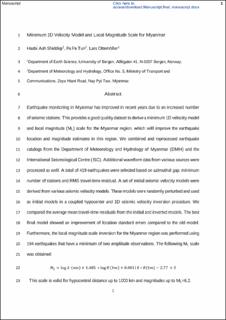Minimum 1D velocity model and local magnitude scale for Myanmar
Journal article, Peer reviewed
Accepted version
Permanent lenke
https://hdl.handle.net/11250/2738491Utgivelsesdato
2019Metadata
Vis full innførselSamlinger
- Department of Earth Science [1050]
- Registrations from Cristin [9791]
Sammendrag
Earthquake monitoring in Myanmar has improved in recent years because of an increased number of seismic stations. This provides a good quality dataset to derive a minimum 1D velocity model and local magnitude (ML) scale for the Myanmar region, which will improve the earthquake location and magnitude estimates in this region. We combined and reprocessed earthquake catalogs from the Department of Meteorology and Hydrology of Myanmar and the International Seismological Centre. Additional waveform data from various sources were processed as well. A total of 419 earthquakes were selected based on azimuthal gap, minimum number of stations, and root mean square travel‐time residuals. A set of initial seismic velocity models was derived from various seismic velocity models. These models were randomly perturbed and used as initial models in a coupled hypocenter and 1D seismic velocity inversion procedure. We compared the average mean travel‐time residuals from the initial and inverted models. The best final model showed an improvement of location standard errors compared to the old model. Furthermore, the local magnitude scale inversion for the Myanmar region was performed using 194 earthquakes having a minimum of two amplitude observations. The following ML scale was obtained
ML=logA(nm)+1.485×logR(km)+0.00118×R(km)−2.77+S.
This scale is valid for hypocentral distance up to 1000 km and magnitudes up to ML 6.2.
